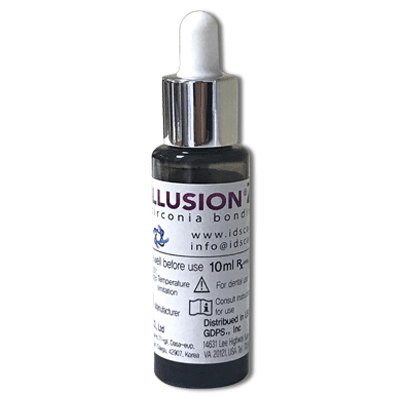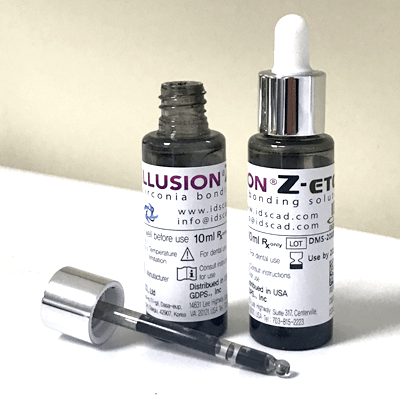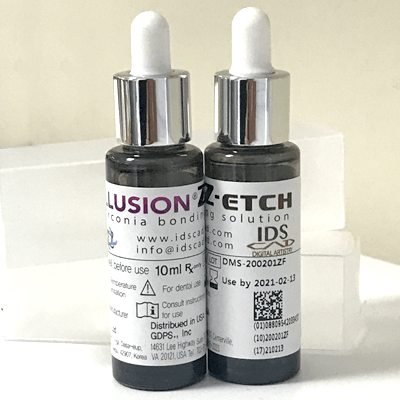Z-etch
$58.00
68 in stock (can be backordered)
68 in stock (can be backordered)
Description
Advanced Nano Tech
- strong bonding strength
- non-corrosive
- non-toxic
- easy application
- thin etching layer
- preserves zirconia’s integrity
The Effect of Z-ETCH Application to the Pre-sintered Zirconia Surface on Bonding Strength
Yong-Bum Jo, DDS, MSD1, Jong-Ju Ahn, BSPH2, So-Hyoun Lee, DDS, MSD, PhD3, Taeseok Park, PhD4, Jung-Bo Huh, DDS, MSD, PhD3
Materials and Methods
1. Specimens Preparation
Eighty cylindrical pre-sintered zirconia discs of 20 mm in diameter and 5 mm in thickness (Zpex Smile, Tosoh, Tokyo, Japan) and Z-ETCH (ZirADD, PNUADD, Busan, Korea) were prepared. All specimens were divided into four groups, including control (no treatment) and three groups, according to Z-ETCH concentration: a slurry containing 1.5 g nano-sized ZrO2 powder compared to 100 g of distilled water as a solvent (ZA15), a slurry containing 3.0 g ZrO2 powder compared to 100 g of distilled water as a solvent (ZA30), and a slurry containing 5.0 g ZrO2 powder compared to 100 g of distilled water as a solvent (ZA50) were prepared for test groups. After all test groups were treated with different concentration of Z-ETCH, they were sintered at 1,530°C for 12 hours (n = 20 in each group). Half of specimen were used for surface roughness test, and the other half were tested for shear bond strength.
2. Surface Morphology Analysis
After surface treatment, zirconia surface was inspected at 5,000X magnification using scanning electron microscopy (SEM) (Gemini SEM300, Carl Zeiss, Oberkochen, Germany). To measure the surface roughness (Ra in μm), profilometer (Mitutoyo Surftest SV 2000, Mitutoyo, Kanagawa, Japan) was used. The surface roughness of the specimen was measured for a distance of 4.8 mm.
3. Specimen Preparation and Shear Bond Strength Test
A cylindrical metal mold having an inner diameter of 6 mm and a thickness of 3 mm was placed on the surface-treated zirconia disc. Self-adhesive resin cement (MAZIC CEM, Vericom, Anyang, Korea) with 10- methacryloyloxydecyl dihydrogen phosphate (MDP) was filled in the metal mold (8 mm outer diameter, 6 mm inner diameter, and 3 mm height) and light cured for 20 seconds on the side and 20 seconds from the top. After light curing, all specimens were stored in distilled water at room temperature for 24 hours before shear bond strength test. Shear bond strength test was performed using a testing machine (OUT-05, Oriental TM Corp., Gyenonggi-do, Korea) at a constant crosshead speed 1.0 mm/ min until failure (Fig. 1).
Fig. 1. Schematic figure of the shear bond test procedure.
4. Statistical Analysis
SPSS software ver. 25.0 (SPSS Inc., Chicago, USA) was used for the statistical analysis and all measured values were evaluated with the 5% of the level of significance. Surface roughness values were analyzed by the Kruskal-Wallis tests with post hoc pairwise Mann-Whitney analyses. And the results of the shear bond strength were analyzed using one-way analysis of variance (ANOVA) and Tukey’s post-hoc test.
RESULTS
Surface roughness images of each experimental group captured by SEM were shown in Fig. 2. The control group showed a typical untreated surface and the test groups showed increasing surface roughness with irregularity.
Fig. 2. The result of surface morphology analysis. Captured images of each experimental groups by SEM (original magnification ×5000): (A) Control, (B) ZE15, (C) ZE30, (D) ZE50.
Additional information
| Weight | 0.1 lbs |
|---|---|
| Dimensions | 3.7 × 0.8 × 0.8 in |
| Special Offers | Z-ETCH 1 + 1, Z-ETCH 30%Off |
You may also like…
-


Effect Colors
$45.00 – $55.00 -

Base Shades
$40.00
Related products
- Sale!


Effect Colors Full Kit
$640.00$580.00 -


BLUE GEL
$28.00



